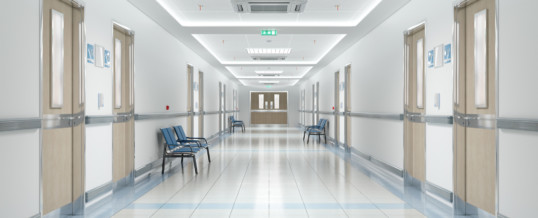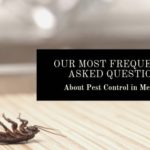
Pests in healthcare facilities literally add insult to injury. The last thing a sick or injured person needs while recovering is annoying and disease-carrying pests! If a facility has pests, pest control should be initiated immediately.
But pest control involves a much bigger picture than just bringing in commercial pest control services or “exterminators.” Rather, it involves what we might call a culture of pest control.
In other words, healthcare staff need to think of pest control as their collective responsibility. We’ll discuss what this entails in the following paragraphs. If all this interests you, stay with us!
The Major Pests in North American Healthcare Facilities
By “healthcare facilities”—we mean not only hospitals, but also medical practices, clinics, retirement facilities, and any other places where professionals prevent or treat illness or injury.
All of these places are subject to pest infiltration that could lead to infestation—which is the last thing anyone wants. Healthcare facilities have delicate ecosystems and need to be protected from the risk of pest infestation.
So, what are the most common of these pests? We’re going to focus here on the top four for North America: cockroaches, bed bugs, flies, and rodents.
Cockroaches
Cockroaches have a long history of grossing people out.
They’re attracted to grease, spoiled food, dark and moist places, bathroom and kitchen plumbing, and other places people hate to deal with. We sometimes ignore the invaders out of revulsion, but definitely shouldn’t.
And roaches literally stink: the uric acid they store in their bodies is a major component of human urine. Although roaches technically do less harm to humans than some other insects, we don’t want them anywhere near us.
Cockroaches and Disease
There are numerous bacteria, fungi, molds, and viruses that cockroaches can spread, not to mention an amoeba that causes dysentery, and another parasite that causes giardiasis.
But asthma caused by an allergy to cockroaches themselves is the big public health concern. A 2005 study found that children living in poorer urban areas in the U.S. were at greater risk of asthmatic illness from cockroach allergy than from allergies to dog or cat dander.
For those who already are sick with something else, one of these illnesses can be doubly awful. Besides, a single cockroach can quickly lead to an infestation–and even greater risk of disease transmission.
Preventing the Entry and Spread of Cockroaches
Here are some preventive measures to try, especially if your facility is located in a crowded area that is prone to roaches:
- Cut off their food supply–including any unwrapped and unsealed food, but also cardboard (especially wet cardboard, which they love).
- Eliminate possible hiding places by clearing up clutter and sealing any holes or large cracks.
- Put out bait periodically and check those areas regularly.
Also, look for evidence of them, such as:
- Dead roaches
- A foul, musty smell
- Cockroach feces (which look like black pepper or coffee grounds)
- Cockroaches fleeing, especially from dark, moist places
- What happens when you put out bait
If you find evidence of cockroaches, calling a pest control service is the best option. In a professional setting like a hospital or retirement home that cares for sick and/or disabled people, time is of the essence in dealing with a pest problem.
Bed Bugs
If there are bed bugs in a healthcare facility, they came in on someone’s clothing–whether staff or patient–or in their belongings. Large cities, where people live in close proximity to one another, are especially prone to bed bugs.
And they can be very hard to get rid of!
Large cities also tend to have large hospitals and other large healthcare facilities. So, the bed bugs–which hide out during the daytime–have a plethora of places to lurk, sleep, or whatever they do.
Bedbugs and Disease
Bed bugs generally don’t carry or spread disease. but they do bite. In fact, like many insects, they require a “blood meal.” They annoy people with their presence–and their bites–which can cause itching and sleeplessness.
In rare cases, bed bug bites can cause anemia due to extensive blood loss. More often, though, the itching can lead to excessive scratching that can sometimes increase the chance of a secondary skin infection.
Preventing the Entry and Spread of Bed Bugs
The best way to prevent bed bugs is regular inspection for the signs of infestation. For example:
- Bloodstains on sheets or pillowcases
- Dark or rusty spots of bedbug excrement on sheets and mattresses, bedclothes, and walls
- Bedbug fecal spots, shells, or shed skins in areas where bedbugs hide
- An offensive, musty odor from the bugs’ scent glands
Another way to prevent bed bugs from taking hold is to cover all mattresses and pillows in specially made covers before the bugs even arrive. By doing this, you are, in effect, starving them–and thereby saving some sick patient further discomfort.
Flies
Flies are everywhere, continually in some places. But they don’t belong in healthcare facilities, so you need to make some serious efforts to prevent their entry. Once they’re inside, they will go everywhere, taking germs with them.
While most of us just put up with the limited number of flies that inevitably come into our homes, waving them away from food and occasionally catching one with a flyswatter, healthcare facilities have more to be concerned about.
Flies and Disease
As with other pests, flies can serve as vectors for spreading illness and disease; they can contaminate food and some species bite. Plus, flies can present an annoyance and a potential danger when they distract medical staff from performing their jobs.
Preventing the Entry and Spread of Flies
First, try to prevent flies from entering the facility. Entryways should be double-door and/or close automatically. Windows should be screened and screens patched when necessary. If possible, eating establishments should be away from entries.
All employees should use common precautions such as keeping garbage, especially food waste, bagged and in closed containers. All fresh food should be refrigerated and/or kept in sealed containers until ready for consumption.
Flies can be challenging, though–an age-old problem. Unlike roaches and bedbugs, houseflies are mostly airborne and tend not to cluster. If they do cluster, though, this probably indicates an infestation.
Check for larvae (maggots) in the places where flies are congregating and kill the larvae with boiling water and a half cup of bleach. Larvae look like tiny pale worms, and they thrive in damp environments near a food source.
And there are always fly traps and baits. But should more common-sense measures fail, calling pest control is imperative–both to address the problem expeditiously and to uphold the facility’s image as being sanitary and well-maintained.
Rodents
Rodents are a different kind of pest. For one thing, they’re mammals, not insects. And they look back at us. So, the goal with rodents is to keep them outdoors. Rodents are no better to have in a hospital or other facility than any other pests.
Rodents and Disease
In fact, rats and mice carry some seriously dangerous diseases, such as hantavirus, plague, salmonellosis, and tularemia. They also carry dangerous insects, like fleas and ticks, that spread even more diseases.
Preventing the Entry and Spread of Rodents
As with the insect pests discussed above, the first key to rodent control is entry prevention. Rodents are larger than insects but still can get through some pretty tiny holes and cracks. So, be sure to seal up any that exist on your premises.
And, like insects, rodents come inside in search of food. The trouble with them is that they have much bigger mouths to feed–and will eat just about anything humans eat.
You also should lay traps for mice and rats, and clean up any nesting sites you find. If at all possible, help them find their way back outside. Whoever cleans up after the rodents should dress appropriately, with gloves, a mask, and protective clothing.
What Are the Pest Control Responsibilities of Healthcare Workers at the Facility?
As we’ve discussed, the best way to prevent a pest problem is by understanding how pests gain access to facilities, what pests are most problematic, where an infestation is most likely to occur, and how to prevent pests in the first place.
To what extent is pest control the responsibility of people working in healthcare facilities, though? Health Facilities Management argues that:
“Due to the complicated physical infrastructure and organizational complexity of health care facilities, the importance of educating all levels of staff and cooperation with an experienced pest management company should not be underestimated.”
The message here seems to be that routine facilities upkeep should be the responsibility of all who work there–to the extent that they’re attentive about such concerns as:
- Where and how to store their personal food
- Alerting custodians to any water leaks
- Alerting a manager to any signs of pests on the premises
- Taking care when entering building not to let flies in
- Checking personal belongings for any pests that might have “hitched a ride”
- Making sure any buffets or hors d’oeuvre remain covered until ready for consumption
The phrase, “If you see something, say something,” often associated with crime prevention, applies here as well. It might not be in your job description to fix a leaking toilet, for instance, but you should notify the person whose job it is.
Are They Gone Now?
Finding pests in a building is not exactly a catastrophe. However, if good pest control habits aren’t practiced, the pests could lead to contagion—which puts both the hospital and its patients at risk. It also leads to a poor reputation.
While most of us deal with pests regularly, especially at certain times of the year, if we’re reasonably healthy, we just tolerate them the best we can until we finally have to call in a commercial pest control service.
But pest control is their job, isn’t it? And don’t they have all kinds of safety protocols that we might never have heard of, much less practice ourselves.
And while healthy people might be able to wait before calling commercial pest control services, hospitals shouldn’t.
So if you work for a hospital or other healthcare facility and have a pest problem, let us know right away. We’ll come and do our job, and soon you’ll forget all about those pesky pests.





